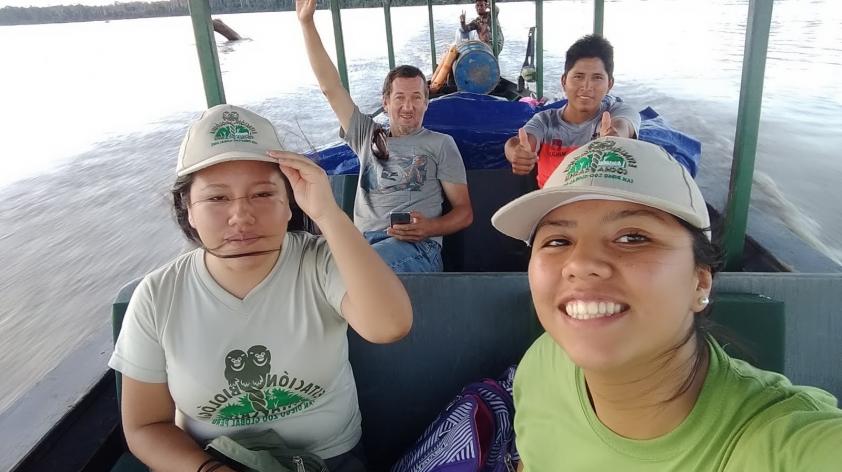
A morning in Tres Islas, a native community in the gold mining area
It is a scorcher in the southwestern Peruvian Amazon. Accompanied by the Giant Otter Conservation Project’s human dimensions team, I climb into a van in Puerto Maldonado, the capital of the Department of Madre de Dios and the main town of the gold mining zone. We take a paved road that quickly turns into gravel and dirt to the community of Tres Islas.
It is 8:00 am and already extremely hot. The van raises small clouds of dust. The route leading to the community has several cleared areas, where slash and burn agriculture is practiced, including cattle pasture, banana and yucca plantations. The community consists of a few wooden houses and stores arranged along the road, with a school and the typical football field on its opposite side.
The Peruvian human dimensions team is led by the diligent Alessandra Cuya, who took over this year and is currently on her third trip to the gold mining zone. The other members are Camila Cok, recently graduated from a Communications program, and Israel Guzman, a young anthropologist.
Tres Islas owns the concession to one of the largest lakes in the area. We have been surveying this lake, its bird community and its giant otter group since the project started in 2017. It is one of the only lakes in the mining zone that provides a stable habitat for a giant otter family group.
We meet the community vice president and Alexander, a young man, at the community center. We discuss our project, monitoring giant otter groups in the mining zone for the last two years. We express our interest in continuing to work together. Our aim is to advance conservation and environmental education.
Alessandra’s team also works in the local school, where it recently gave a workshop on the aquatic ecosystem and especially the biology of the giant otter.
Alexander and the vice president tell us about their efforts to develop a tourism project in the community. This included heavy investment in time and money from several community members. Besides agriculture and mining, they see tourism as one of the possible ways in which it is possible to generate income for the community.
They do have trouble with a group of illegal miners that work near the lake banks. They understand that bank destruction represents not only damage to the local ecosystem and its animals but may also hinder any tourism initiative because people are less likely to want to visit a lake with destroyed banks. This is one of the reasons why the tourism initiative is currently on hold.
After our brief discussion, the team splits up to conduct a few interviews. The idea is to understand the human composition of the community, the main economic activities of its inhabitants and their perceptions towards the environment.
Tres Islas is interesting because it is a native community. Its people have good awareness of how humans affect the environment. We meet Miguel (not his real name), a gentleman hanging around the community’s main store. He is willing to answer our questions.
Interviews commonly last 30 to 45 minutes and have a fixed format. In this case, Miguel does not stick to the script. He relates his experiences of investing money in agriculture and helping with the community’s tourism project.
Miguel also tells us about the types of fish he finds in the lake and the game animals he hunts in the area, especially the lowland paca. The interview lasts over an hour, during which he expresses his opinions on mining activities and the pollution and destruction they bring to the local ecosystem.
We thank Miguel and our hosts and agree to continue working with the community in the future. We propose to present our observations of the giant otter group in a future community meeting. It is already noon, the sun is high in the sky and the heat becomes unbearable. We head back to Puerto Maldonado.
Every community has its story. We are beginning to scratch the surface of the human mosaic of the Madre de Dios area. Visits such as this will help us understand how to better work towards the conservation of Amazon aquatic ecosystems. Some of the lakes we study show signs of deterioration and we suspect this is affecting one of the region's top predators, the giant otter.













